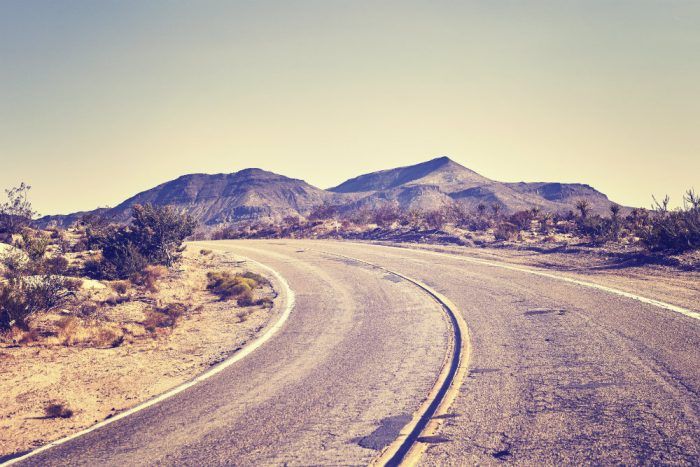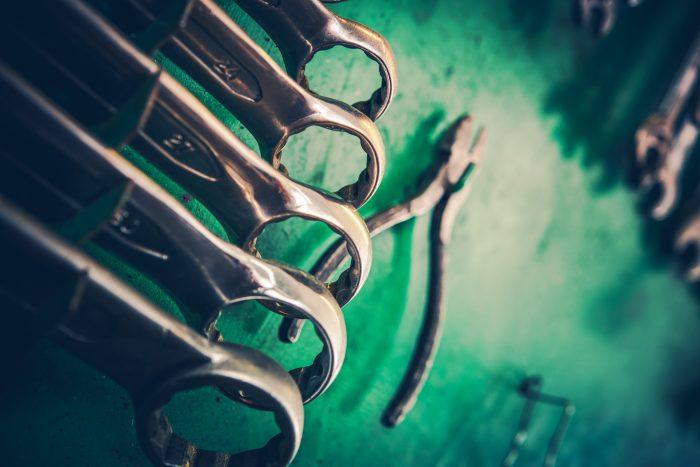I’m in the middle of the southern Arizona desert blasting north at 75 miles an hour. I’m at that rise, just beyond the Boarder Patrol checkpoint, when I glance in the rearview mirror and see it all laid out before me.
“Back there,” I think, “is everything I know in a certain sense.”
Memory Reflector
Recently both my parents died, and I have just (finally, finally) settled up everything, and have gotten my ass out of what I can only relate to as being a horrid place to live. Back there, in that rearview mirror is the past. Not just the literal past, where I was driving a few moments before, but my past. My parents house where they retired. Three bedrooms and two baths of stuff neither me nor my brothers really wanted, but a house that now, in my mind’s eye, is some sort of strange reflector of memories on top of memories on top of memories.
It hits me that I am not driving a car, and a limited-run racing special with a “significant” competition history at that. No, I’m not driving a car, I’m driving a time machine. In here, it’s the present. In the rearview mirror, it’s the past. And out there, on the other side of that windshield, is the future.
Cars are interesting things. They’re more than art objects or a way to get dates; or a way to show off or a way to get you from point A to B. Cars are, in their own way, time machines.
And the future is roaring more than a mile a minute.

The Future In Front of Me, The Past Behind Me is a gasoline-fueled narrative by automotive journalist Tony Borroz. It details the joys, thrills, and even the uncertainties of the car-obsessed lifestyle. In advance of the book’s release, a new chapter appears every Friday on Automoblog.
Farm Boy
In a lot of ways, this was a (lower case r) revelation that was a long time coming. This is not about the passing of my parents, although, in almost every way imaginable, this is all my dad’s fault. Thanks to my father, I grew up in a car-oriented family. The garage – there was always a garage – was packed full of sports cars, antique cars, sensible work cars, and tools, literally thousands of tools.
By the time I knew my father, he was a tool and die maker at an aluminum factory. Before that, his job was killing Germans, and before that he was a coal miner. Before that, he grew up on a farm in rural Illinois in a town that literally disappeared during the Great Depression. In other words, he found himself in a lot of situations where he had to work with a lot of mechanical things and, even more to the point, he had to be able to fix them. So, being a tool and die maker was a natural fit for a farm kid who was, for a time being, a drill sergeant who, for a time being had to Make It Work, no matter what a bunch Fascists thought.
Or, as my dad once put it, “It’s a great job. I get to make stuff out of metal and no one is shooting at me.”
He loved working in aluminum, or ‘luminum, as he said it in his Colorado cowboy twang. “It’s soft, easy to work, and if you know what the metal is doing, it can take really high loads with out deflecting an inch. You can work it to really high tolerances and it cuts like butter.”
Obsessions & Passions
And of course there were cars. Everybody, and I mean literally everybody in his family was seriously obsessed with cars. Partially I figured it was a genetic thing. Italians have this odd fascination with speed that a lot of other cultures lack. We invented circuit racing, for example. All that Ben-Hur chariot racing stuff? The Italians were running chariot races for centuries before that movie was set.
The odd thing here is sports cars. Unlike a lot of Americans, and especially the ones where I grew up, my father had little to no interest in hot rods and muscle cars. He liked sports cars. Cars that could not just go, but go, turn, and stop. Cars that were no bigger and no heavier than they had to be.
Ergo, when my oldest brother, Terry, turned 16 and got a car, it was a Triumph TR-4 (red with the dog dish hubcaps). When my other older brother, John, turned 16 and got a car, it was an MG-B (antique white). When I turned 16, I got a Mercury Capri II with the 2.8-liter V6 engine. The biggest you could get. As my dad always said, “If you’re going to get a car, get the one with the all the hot options.”
My dad seemingly had thousands of those little truisms, some coming from the Army, some coming from the Farm, but the vast bulk of them coming from direct experience.
“You can find lots of idiots that can hold their foot down. That’s not being a race car driver. Knowing when to hit the brakes and turn, that makes you a race car driver.”
“You can never have enough tools.”
“Any oil leak is a problem,” said over my brother’s TR.
And my personal favorite: “Finding interesting cars is easy. Finding garage space, that’s the problem.”

Borroz often recites his father’s sayings in conversation, especially when asked about the mythical “Tony’s Lottery Garage.” While there are many cars in Tony’s Lottery Garage and new ones can be added at random, the one guarantee is available space.
Family Dynamics
My being a gearhead was foretold even before I was conceived. It wasn’t just cool cars in the garage and talk of new limited slip differentials at the dinner table. If there was racing coverage on TV, it was on. If the new Autoweek & Competition Press showed up in the mailbox, hierarchical birth-order and body size clashed against cunning and desire. Before dad got home. Precisely at 4:50 to be followed by dinner precisely at 5:00. Then that week’s copy of Autoweek & Competition Press was his.
And the same went for Road & Track, Car & Driver and any other thing in print that found its way into our home. Did I mention that my dad was a (precise) tool and die maker? Did I mention that my dad was a (by the book) drill instructor? Did I mention that my dad was sort of an anal retentive jerk? He was.
Racing on TV was watched in reverent silence balanced with barely contained contempt for the commentary crew. “These idiots excel at telling ya somethin’ ya already seen.” My dad, of course. The quiet only being broken by the occasional “Uh-oh!” when someone uncorked it. Post race after action reports could sometimes last for weeks. “Yeah, but if Mario didn’t break-” “Yeah, but he did! And the whole point being that Unser-” “Oh screw Unser! That guy’s never turned a wheel in a sports car, let alone a Grand Prix car.” “Yes, but we weren’t watching the Grand Prix, were we? No. We were watching the USAC race at Ontario.” “Which just proves my point . . . ”
And on it went.
I swear my brothers would still devolve into an argument about whether Richie Ginther really was robbed at that race at Torrey Pines that one day.
Remarkable Parallels
I realize, of course, this is not all that different from baseball families (“Oh Lou Gehrig my butt!”) or basketball families (“Yeah, but Bill Russell was playing against little white guys!”) or, perish the thought, families who were sadly obsessed with [shudder] golf.
Years ago I had the great opportunity to work on some pre-packaged TV coverage of formula racing. One of the racers involved in Formula Atlantic at that time was a guy named Mark Dismore (who was having a knock-down-drag-out championship battle with Hiro Matsushita). Finished with his interview, we were hanging out with Dismore back at the transporter in the paddock. The show’s producer, this really nice guy named Tommy Coggins who worked as a shooter with me on many a gig, asked Dismore, “So how did you get into doing something like racing?”
Tommy was a baseball guy. He had never really watched racing on TV, let alone been to a race, let alone seeing how close to unmitigated disaster these guys worked. It pretty much put the zap on his head, seeing it in person. His question was more akin to, “You go out and face off against a bull with a piece of cloth?!”
“Oh, you know,” Dismore said with a resigned smile. “Family. My dad raced. My uncle ran a machine shop. You know. Some people grow up in baseball families, and some people grow up in basketball families, I grew up in a racing family.”
Dismore delivered it with that “it’s kinda obvious” tone.
Tommy Coggins didn’t get it right away, but I did.
The Road Ahead
My predilections were pre-ordained, but my future was not. Indeed our future, the future of the gearheads and automotive enthusiasts of this world, are seemingly more and more in doubt with every passing day. Gearheads in the 50s had a secure gearhead future to look forward to. “20 years from now? Well shoot, cars will be powered by jet engines and cruising at a hundred miles an hour on pool-table-smooth superhighways!” That’s what we, the gearheads, would have been saying in 1958.
Now? In 2018? You tell me where cars will be by 2038? Will there still be cars? If there are, will we be allowed to drive them?
That . . . this . . . all of this, my father, my family, where cars and racing were, where cars and racing will be . . . all of this washes through my mind as I blast through the desert at 80, one eye in the rearview mirror, one eye on the road ahead.
Tony Borroz has spent his entire life racing antique and sports cars. He is the author of Bricks & Bones: The Endearing Legacy and Nitty-Gritty Phenomenon of The Indy 500, available in paperback or Kindle format. A chapter from his forthcoming new book The Future In Front of Me, The Past Behind Me appears every Friday on Automoblog. Follow his work on Twitter: @TonyBorroz.
from Automoblog.net https://ift.tt/2qaMIUw
No comments:
Post a Comment